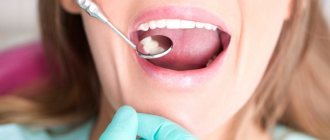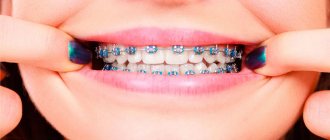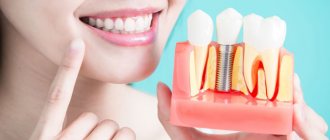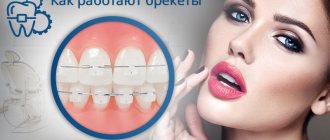Glucose is the main source of energy for the human body. It can enter the body as part of sweets or as part of more complex carbohydrates. The latter option does not have a negative effect on the oral cavity. But fast carbohydrates (or, more simply, sugar) destroy teeth and lead to the development of many diseases.
Almost all people are aware that sweets are harmful to teeth. But not everyone knows why sugar is harmful to teeth
How does sugar affect teeth and is it possible to avoid the harmful effects?
Every dentist, when asked whether sugar is harmful to teeth, will answer in the affirmative.
The main reason is that simple carbohydrates begin to break down in the oral cavity, and acidity changes accordingly. This leads to the creation of optimal conditions for pathogenic bacteria, they begin to multiply and damage the enamel. Spots form, and then cavities - this is how caries develops. In addition, the acidic environment itself has a destructive effect on tooth enamel, which makes it easier for bacteria to enter the tissue. Not every person is ready to completely give up sweets, but it is recommended to limit the amount. You can replace your usual sweets with less harmful products:
- honey (contains not only sugar, but also many elements beneficial to the body);
- fruits and berries (sweet, but rich in vitamins, macro and microelements);
- dried fruits (contain the same set of useful components as fresh fruits, but are suitable for lovers of richer sweet tastes);
- nuts (some of the varieties have a sweetish taste, while being a source of protein);
- desserts with fructose (the taste is no different from ordinary sweets, but does not cause such devastating damage to the enamel).
How to minimize harm from sweets
The best option is to completely give up sweets. But for most adults, and especially for children, this option is unacceptable. According to statistics, there are very few people who are absolutely indifferent to sweets.
There are some recommendations for proper consumption of sweets, following which helps reduce the negative impact of sweets on teeth.
- The right treats . Experts recommend eating soft, but not sticky treats. For example, instead of toffees and marshmallows, it is better to choose cream cakes. They do not stick to tooth enamel and are easily removed after a couple of sips of drink.
- Sweets after meals . This rule is often voiced by parents to their children. After all, by eating sweets, you can “kill” your appetite. Dentists state this rule a little differently. During a meal (eating soup or side dish), a process of abundant saliva production occurs in the oral cavity. It is in this environment that sweets should be placed in order to neutralize organic acid as much as possible.
- Diet . Eating sweets should not be spread out over the whole day. It is recommended to eat the entire portion at one time. Constant snacking on sweets, cookies and chocolate regularly feeds bacteria. Such eating of sweets can lead to rapid destruction of enamel and the development of caries.
- Maintaining hygiene . From early childhood, you need to teach your child to brush their teeth. To reduce the negative impact of sweets on your teeth, you need to rinse your mouth after eating it. If this is not possible, then rinsing can be replaced by short-term use of chewing gum.
Variants of the effects of sweets on teeth
There are two main directions of the negative effect of sugar on the dental apparatus:
- Glucose, entering the human body, must be digested and absorbed. In order for the process to occur correctly, a number of helping elements are required: calcium and B vitamins. These components are contained in the teeth, therefore, with regular consumption of sweets, they are gradually washed out, which is why the teeth become more fragile and are destroyed.
- After brushing your teeth, within half an hour a huge number of bacteria appear on the surface. Glucose is the best nutrient medium for almost all types of bacterial agents, so their active growth begins. An excessive increase in the number of bacteria, even those that are normally found in the oral cavity, leads to the development of inflammatory processes.
What are the dangers of sweets?
Almost all sweet products: sugar, soda and syrups, jam, confectionery, sweet fruits (bananas, strawberries) are classified as simple carbohydrates. Such foods are broken down very quickly in the body and increase the amount of glucose in the blood, adding energy. This is effective before sports. When energy is not wasted, it is deposited in the form of fat reserves.
To break down and absorb simple carbohydrates, the body needs B vitamins and calcium. Teeth become a source for quickly obtaining the necessary macronutrients.
If the diet does not have enough vitamins and calcium, and a person consumes sweets excessively, then the expended reserves of necessary substances do not have time to be restored. This is how the process of internal tooth decay occurs. During this process, the enamel becomes thinner and caries develops.
What foods are the most dangerous?
Dentists have compiled a list of foods that are the worst for teeth. The first three places are occupied by the following well-known delicacies:
- Taffy . Stretchy candies stick to teeth, get clogged in gaps and remain in the oral cavity for a long time. Therefore, the active growth of bacteria increases, as a result of which the enamel is destroyed faster and more severely.
- Caramel . The destructive effect of caramels is due to the fact that the sweetness consists of almost 60% pure sugar. When absorbed in the mouth, it affects the dentition for a long time and manages to activate the growth of pathogenic microorganisms.
- Chocolate . About 50% of pure sugar is found in chocolate. However, dark (or bitter) chocolate is much less harmful. In addition, scientists have proven that cocoa beans have a disinfecting effect. But there are few of them in milk and white chocolate, so the harm of sugar outweighs.
Caramels and Chupa Chups
Sweets such as caramels and lollipops are also prohibited. Again, due to their presence in the oral cavity for too long. Within 5 minutes, while we eat caramel, not only we, but also bacteria feed on it. Accordingly, we ourselves - voluntarily and enjoying the taste - create a breeding ground for bacteria in our mouths and spoil our teeth. Moreover, it turns out to be a vicious circle: we eat caramel, try to enjoy it longer, at this time bacteria are actively fed and their adhesion is stimulated, which causes the development of infectious processes in the mouth.
How to reduce the effect of sugar on your teeth?
When consuming sweets, you can use a number of recommendations to reduce the harmful effects on enamel. These include:
- Drink enough fluids (to ensure that bacteria and sugar residues are washed away).
- Eating sweets after the main meal (when a large amount of saliva remains in the mouth).
- Refusal of frequent snacks, especially sweets (the more often you eat, the more bacteria will form, especially if you eat sweet foods).
- Daily careful personal hygiene (you need to not just brush your teeth twice a day, but also follow all the rules: brush for at least 2 minutes, don’t forget about your tongue, choose the right brush, toothpaste, use dental floss, mouthwash).
To avoid negative consequences, do not forget about preventive visits to the dentist, especially if you like to eat sweets.
Rules for eating sweets
By following the rules, you will extend the life of your teeth and avoid treatment at the dentist:
- Give preference to non-sticky, but soft sweets. Cream pies and cakes in small quantities are what you need to enjoy. The soft cream is removed from the teeth after a few sips of tea, without becoming food for bacteria.
- Eating dessert should not take a long time. 10-15 minutes - and you can brush your teeth. If you sit and stretch out the pleasure, washing down each bite with tea or soda, and snacking on sweets throughout the day, exceeding the norm will affect not only your figure, but also your dental health.
- After consuming sugar-containing foods, the oral cavity must be cleaned of food residues that provoke the growth of bacteria. At home, you can brush your teeth or use a mouthwash. When working or walking, rinse your mouth with at least mineral water.
DaVinci dentists do not recommend using sugar-containing chewing gum to remove food debris. The composition of oral hygiene products provides for the destruction of bacteria that eat sweets. You need to get rid of the habit of using lollipops to freshen your breath. Chewing gum, breath candies and freshness are incompatible things.
Add a comment
Leave your comment
Forgot about fructose. How are things going with her?
With fructose, everything is ambiguous.
Fructose, in fact, is not particularly needed by our body - practically no cells can absorb it in its pure form, so the liver converts fructose into glucose. This process uses enzymes that we don't have much of, so much of the fructose is immediately converted into fat. Let's imagine that by eating a regular cookie, we can burn off the resulting glucose by exercising while it circulates in the blood and has not turned into fat. This “trick” will not work with fructose-containing cookies.
Fructose is processed without the participation of insulin, but there are still more disadvantages in this situation: eating disorders, a very delayed feeling of satiety, and again metabolic syndrome, one of the signs of which is insulin resistance.
With fruits it's different. In them, fructose is bound to fiber, which slows down its release, and it is also extremely difficult to eat enough fruit to get a dose of sugar equivalent to a chocolate bar.
Myth 6: As long as the tooth doesn’t hurt, you don’t need a dentist
In this case, we must remember the rule that it is easier to prevent a disease than to cure it. It is also applicable in dentistry. Most dental pathologies do not manifest themselves in any way at an early stage. But a competent dentist can detect changes during examination and immediately take action to prevent the development of the disease. Even if there are no complaints, you should visit the dentist at least 2 times a year. It is easier and cheaper to fix a problem early than to deal with a serious problem with many complications.
Myth 10: Teeth whitening destroys enamel
The statement is true only if we are talking about folk “masterpiece recipes” that are used for home whitening. This often leads to problems: destruction of enamel, increased sensitivity of teeth, burns of the mucous membrane. Professional whitening occurs due to active oxygen, which penetrates deep into hard tissues and discolors dentin pigments. The method is gentle and allows you to whiten your teeth by 6-12 shades in 1 session. Active oxygen does not destroy or change the structure of the enamel layer and does not damage dental tissue.
Myth 9: You can correct your bite only in childhood
Bite correction is possible at any age. There are many methods and technologies in the arsenal of modern orthodontics that allow you to safely straighten your teeth and create a beautiful smile. Of course, the younger the patient, the faster and easier the processes of moving teeth in a row and correcting the bite occur. At an older age, treatment will take longer. But there is no upper age limit for orthodontic treatment. It is important that the patient retains a sufficient number of teeth. If large segments of dental units are missing, there will simply be nothing to install the corrective apparatus (braces, aligners) on.
All clear. I won't eat sweets, is that enough?
No, unfortunately, this is not at all enough.
Nowadays, the concept of “added sugar” has appeared; it is found in products where it should not normally be present. Sugar appears in kindergarten borscht and vegetable stews, if you check the technological map, and is found in store-bought sauces, semi-finished products, bread, packaged juices, baby formula and yoghurts. Bread can be as varied as you like with sprouted grains of all kinds of crops, but almost every “brick”, every “loaf” contains about 4 tablespoons of sugar. The inscription “sugar-free” on the label is currently even more alarming than the honest sugar in the composition.
Sugar has many synonyms in the food industry: molasses, molasses, grape sugar, coconut sugar, brown rice syrup, glucose-fructose syrup, maltodextrin, honey, invert sugar, agave syrup, Jerusalem artichoke syrup - about 60 names in total.
When we eat a cereal bar, we first get a dose of broken down carbohydrates and only then the potential benefits of a piece of fruit or traces of grains.
Russian “Japanese” cuisine can be distinguished separately - to prepare rice for sushi, rice vinegar and sugar, ginger and Wasabi seasoning, Teriyaki and Blue Cheese sauces, which also contain sugar, are used. Instead of immodest fish and rice, it’s more honest to eat a chocolate bar.
It is the added sugar that poses the biggest problem - while we can consciously give up obviously sugary foods, such as candy and baked goods, then the added sugar is hiding in places we didn’t expect.
Treatment of demineralization
If the problem is not addressed in time, demineralization can develop into caries and then into pulpitis. How to treat the disease?
The worst way is to wait for the spots to go away on their own. This will not happen, so if you have symptoms of demineralization, you should contact your dentist, even if the process is noticed on children’s baby teeth.
In the early stages, it is quite possible to overcome demineralization. After a thorough examination, the doctor prescribes treatment, which, as a rule, consists of several points:
- treatment of dental diseases;
- in the presence of orthodontic structures - careful care;
- limiting sweets and sugar-containing products;
- thorough and regular teeth cleaning;
- proper nutrition.
In addition, sometimes specialists carry out remineralization of enamel with special solutions and gels, which include fluorine, fluorides and calcium. This helps completely restore the enamel. Another procedure for treating demineralization is dental fluoridation.
Now you know why sweets are so dangerous for our teeth. Of course, you won’t be able to completely deprive yourself of pleasure, but in order to prevent demineralization, after a treat you should brush your teeth, rinse your mouth with water or chew sugar-free gum, leaving no chance for harmful bacteria.
What is useful?
Add more fruits and vegetables to your baby’s diet: apples, cabbage and carrots, due to their hard structure, remove plaque from the surface of the teeth, all red and purple berries prevent the formation of a bacterial film on the enamel, and any greens have an anti-inflammatory effect. Be careful with citrus fruits: they are useful only in moderate doses, otherwise the acid they contain can harm the enamel.
Cereals, grains and bran increase salivation, which helps wash away plaque and food debris; fish and seafood are rich in minerals to strengthen enamel. Dairy products are also very important; they must be included in the diet, but not given at night.
The menu that is healthy for teeth is actually varied! But what to do if the baby still misses sweets? Remember that it is the sugar particles that are harmful, not the sweets themselves. Therefore, if you follow the rules, sweets will not cause much harm. Come up with your baby, for example, on Sweets Day, which will take place once a week/month, and give goodies only on this day. The child will get used to the rules and will not ask for candy at other times. Also, do not give sweets at night or as a snack; after chocolate, offer your baby a piece of apple or other solid food, and be sure to brush your teeth before bed.
SWEET CAN BE HEALTHIER!
XyliPOP miradent® strawberry flavored lozenges contain calcium lactate, which restores the mineral balance of teeth, as well as xylitol, which saturates enamel with minerals and resists bacteria that cause caries.
TASTY!
The juice of children's favorite berries - wild strawberries, strawberries - has bactericidal properties. This is a good remedy for the prevention of caries, which the baby will not refuse.
Buns and cakes
If we are talking about baking, then there is only danger from nutritional science. Various rolls, pastries, cakes with different creams - protein, sour cream, butter - do not harm your teeth at all. The same principle works here as with chocolate: such sweets do not stay in the mouth for a long time, we chew them and again stimulate the washing of the teeth with saliva, followed by their mineralization. Therefore, this option can also be called harmless to human teeth.
So fickle! How to protect baby teeth from caries Read more
Protect yourself from sugar
The “brush your teeth after eating potentially harmful sugars” option is not 100% effective. Of course, cleansing will remove any stuck-on candy and toffee. However, it is worth understanding that all the time we were eating sweets that negatively affected the condition of our teeth, we were feeding bacteria. This means that we have already provided a potentially tasty environment for them.
To keep your teeth healthy, if you really want caramels, for example, you need to eat them extremely rarely, and then rinse your mouth with clean water. Of course, you should undergo preventive examinations with a dentist at least once every six months so that you can see the initial processes of caries development in time. Also, to maintain dental health, you should use modern hygiene products: dental floss, dental brushes and irrigators. If all this is used on time and correctly, your teeth will enjoy good health for a long time.
Negative sides
In addition, sugar can destroy dental units. Thanks to sweets, many people crowd out other, more nutritious foods from their diet. As a rule, “sugar” is understood as sucrose. But there are plenty of varieties of sugar, as well as degrees of sweetness. Fructose (found in honey and fruits) takes the lead in sweetness. Then, in turn, come sucrose (the basis of sugar beets and sugar cane), glucose (found in vegetables, fruits, honey), maltose (component in grains), lactose (in milk sugar).
Where to contact in Moscow
Dentistry in Moscow is not uncommon, but a competent dentist is worth his weight in gold. Ilatan Clinics provide a full range of dental services: high-precision diagnostics and high-quality treatment of any dental problems. Ilatan dentistry in Moscow offers advanced equipment, latest generation materials, innovative technologies for prosthetics, whitening, dental fillings, safe anesthesia, painless treatment and experienced doctors.











